Durability Improvement of Biocemented Sand by Fiber-Reinforced MICP for Coastal Erosion Protection
Abstract
:1. Introduction
2. Materials and Methods
2.1. Fiber Material Used in This Study
2.2. Used Bacteria and Soil Properties
2.3. Sample Preparation for Cyclic Wet–Dry Tests
3. Results and Discussion
3.1. Physical Changes and Weight Loss
3.2. Strength Deterioration Ratios
3.3. Measurements of Shear-Wave Velocity
3.4. Microstructural Analysis (SEM and XRD) of the Treated Samples
3.5. Durability Characteristics and Mechanisms
4. Conclusions
- I.
- In both DW and ASW, cyclic wet–dry (WD) effects appear to have a negative impact on the mechanical and physical properties of fiber-reinforced MICP-treated samples. The dissolution of calcium carbonates and bonding effects between sand particles was discovered to be involved in the deterioration of MICP samples caused by WD cycles, and this occurred in two stages: short-term and long-term;
- II.
- As a result of the suspension and degradation of the powdered carbonate accumulations, short-term disintegration occurred rapidly within the first couple of WD cycles in DW. After 15 WD cycles in ASW, long-term degradation was observed;
- III
- The fatigue stresses generated during the WD cycle have the potential to break the primary bonds, affecting the surface of the specimens in particular. However, the addition of jute fiber improved the bonding effects and increased the aggregate stability and physical durability. Our findings also revealed that the MICP-treated samples are less vulnerable to WD cycle treatments (DW cases), i.e., more stable behavior in DW cases compared with that in ASW cases. However, the addition of fiber could significantly improve the strength and durability of the MICP-treated samples;
- IV.
- Natural jute fiber was used in this work; nevertheless, the impacts of chemically treated jute fiber and fiber roughness (surface) were not thoroughly studied in terms of improvements in strength and durability. More research is needed for better understanding of the impacts of fiber-reinforcement on soil stabilization via the MICP process (considering chemical pretreatment of the fiber, fiber roughness, etc.)
Author Contributions
Funding
Institutional Review Board Statement
Informed Consent Statement
Data Availability Statement
Conflicts of Interest
References
- Shanahan, C.; Montoya, B.M. Erosion Reduction of Coastal Sands Using Microbial Induced Calcite Precipitation. In Proceedings of the Geo-Chicago 2016, Chicago IL, USA, 14–18 August 2016; American Society of Civil Engineers: Reston, VA, USA, 2016; pp. 42–51. [Google Scholar]
- Jiang, N.-J.; Soga, K. Erosional behavior of gravel-sand mixtures stabilized by microbially induced calcite precipitation (MICP). Soils Found. 2019, 59, 699–709. [Google Scholar] [CrossRef]
- Shahin, M.A.; Jamieson, K.; Cheng, L. Microbial-induced carbonate precipitation for coastal erosion mitigation of sandy slopes. Géotech. Lett. 2020, 10, 211–215. [Google Scholar] [CrossRef]
- Mortensen, B.M.; Haber, M.J.; DeJong, J.T.; Caslake, L.F.; Nelson, D.C. Effects of environmental factors on microbial induced calcium carbonate precipitation. J. Appl. Microbiol. 2011, 111, 338–349. [Google Scholar] [CrossRef] [PubMed]
- Chen, M.; Gowthaman, S.; Nakashima, K.; Komatsu, S.; Kawasaki, S. Experimental Study on Sand Stabilization Using Bio-Cementation with Wastepaper Fiber Integration. Materials 2021, 14, 5164. [Google Scholar] [CrossRef] [PubMed]
- Miftah, A.; Khodadadi Tirkolaei, H.; Bilsel, H. Biocementation of Calcareous Beach Sand Using Enzymatic Calcium Carbonate Precipitation. Crystals 2020, 10, 888. [Google Scholar] [CrossRef]
- Al Imran, M. Combination Technology of Geotextile Tube and Artificial Beachrock for Coastal Protection. Int. J. Geomate 2017, 13, 67–72. [Google Scholar] [CrossRef]
- Keykha, H.A.; Romiani, H.M.; Zebardast, E.; Asadi, A.; Kawasaki, S. CO2-induced carbonate minerals as soil stabilizing agents for dust suppression. Aeolian Res. 2021, 52, 100731. [Google Scholar] [CrossRef]
- Imran, M.A.; Gowthaman, S.; Nakashima, K.; Kawasaki, S. The Influence of the Addition of Plant-Based Natural Fibers (Jute) on Biocemented Sand Using MICP Method. Materials 2020, 13, 4198. [Google Scholar] [CrossRef]
- Miftah, A.; Garoushi, A.H.B.; Bilsel, H. Effects of Fine Content on Undrained Shear Response of Sand–Clay Mixture. Int. J. Geosynth. Ground Eng. 2020, 6, 10. [Google Scholar] [CrossRef]
- Omoregie, A.I.; Palombo, E.A.; Ong, D.E.L.; Nissom, P.M. A feasible scale-up production of Sporosarcina pasteurii using custom-built stirred tank reactor for in-situ soil biocementation. Biocatal. Agric. Biotechnol. 2020, 24, 101544. [Google Scholar] [CrossRef]
- Jiang, N.J.; Tang, C.S.; Yin, L.Y.; Xie, Y.H.; Shi, B. Applicability of Microbial Calcification Method for Sandy-Slope Surface Erosion Control. J. Mater. Civ. Eng. 2019, 31, 04019250. [Google Scholar] [CrossRef]
- Jiang, N.; Wang, Y.; Chu, J.; Kawasaki, S.; Tang, C.; Cheng, L.; Du, Y.; Shashank, B.S.; Singh, D.N.; Han, X.; et al. Bio-mediated soil improvement: An introspection into processes, materials, characterization and applications. Soil Use Manag. 2022, 38, 68–93. [Google Scholar] [CrossRef]
- Zhang, W.; Bhubalan, K.; Dittrich, M.; Zhu, T. Carbonate Precipitation through Microbial Activities in Natural environment, and Their Potential in Biotechnology: A Review. Front. Bioeng. Biotechnol. 2016, 4, 4. [Google Scholar] [CrossRef] [Green Version]
- Hamed Khodadadi, T.; Kavazanjian, E.; van Paassen, L.; DeJong, J. Bio-Grout Materials: A Review. In Proceedings of the Grouting 2017, Honolulu, HI, USA, 9–12 July 2017; American Society of Civil Engineers: Reston, VA, USA, 2017; pp. 1–12. [Google Scholar]
- Nayanthara, P.G.N.; Dassanayake, A.B.N.; Nakashima, K.; Kawasaki, S. Microbial Induced Carbonate Precipitation Using a Native Inland Bacterium for Beach Sand Stabilization in Nearshore Areas. Appl. Sci. 2019, 9, 3201. [Google Scholar] [CrossRef] [Green Version]
- Gowthaman, S.; Nakashima, K.; Kawasaki, S. A State-of-the-Art Review on Soil Reinforcement Technology Using Natural Plant Fiber Materials: Past Findings, Present Trends and Future Directions. Materials 2018, 11, 553. [Google Scholar] [CrossRef] [Green Version]
- Velardo, P.; Sáez del Bosque, I.F.; Sánchez de Rojas, M.I.; De Belie, N.; Medina, C. Durability of concrete bearing polymer-treated mixed recycled aggregate. Constr. Build. Mater. 2022, 315, 125781. [Google Scholar] [CrossRef]
- Imran, M.; Kimura, S.; Nakashima, K.; Evelpidou, N.; Kawasaki, S. Feasibility Study of Native Ureolytic Bacteria for Biocementation Towards Coastal Erosion Protection by MICP Method. Appl. Sci. 2019, 9, 4462. [Google Scholar] [CrossRef] [Green Version]
- Wang, Z.; Zhang, N.; Cai, G.; Jin, Y.; Ding, N.; Shen, D. Review of ground improvement using microbial induced carbonate precipitation (MICP). Mar. Georesour. Geotechnol. 2017, 35, 1135–1146. [Google Scholar] [CrossRef]
- Natarajan, K.R. Kinetic study of the enzyme urease from Dolichos biflorus. J. Chem. Educ. 1995, 73, 556–557. [Google Scholar] [CrossRef]
- Gowthaman, S.; Nakashima, K.; Kawasaki, S. Effect of wetting and drying cycles on the durability of bio-cemented soil of expressway slope. Int. J. Environ. Sci. Technol. 2022, 19, 2309–2322. [Google Scholar] [CrossRef]
- de Klerk, M.D.; Kayondo, M.; Moelich, G.M.; de Villiers, W.I.; Combrinck, R.; Boshoff, W.P. Durability of chemically modified sisal fibre in cement-based composites. Constr. Build. Mater. 2020, 241, 117835. [Google Scholar] [CrossRef]
- Wang, X.; Tang, Y.; Huang, B.; Hu, T.; Ling, D. Review on Numerical Simulation of the Internal Soil Erosion Mechanisms Using the Discrete Element Method. Water 2021, 13, 169. [Google Scholar] [CrossRef]
- Gowthaman, S.; Nakashima, K.; Kawasaki, S. Freeze-thaw durability and shear responses of cemented slope soil treated by microbial induced carbonate precipitation. Soils Found. 2020, 60, 840–855. [Google Scholar] [CrossRef]
- Gui, R.; Pan, Y.-X.; Ding, D.-X.; Liu, Y.; Zhang, Z.-J. Experimental Study on the Fine-Grained Uranium Tailings Reinforced by MICP. Adv. Civ. Eng. 2018, 2018, 2928985. [Google Scholar] [CrossRef] [Green Version]
- Ma, G.; Yan, L.; Shen, W.; Zhu, D.; Huang, L.; Kasal, B. Effects of water, alkali solution and temperature ageing on water absorption, morphology and mechanical properties of natural FRP composites: Plant-based jute vs. mineral-based basalt. Compos. Part B Eng. 2018, 153, 398–412. [Google Scholar] [CrossRef]
- Hannant, D.J. Fibre-reinforced concrete. In Advanced Concrete Technology; Elsevier: Amsterdam, The Netherlands, 2003; pp. 1–17. ISBN 9780080526560. [Google Scholar]
- Tri Huynh, N.N.; Tu, T.A.; Huong Huyen, N.P.; Khanh Son, N. Lab-Scale Experiments For Soil Cementing Through Bio-Chemical Process. ASEAN Eng. J. 2021, 11, 255–265. [Google Scholar] [CrossRef]
- Gowthaman, S.; Nakashima, K.; Kawasaki, S. Durability analysis of bio-cemented slope soil under the exposure of acid rain. J. Soils Sediments 2021, 21, 2831–2844. [Google Scholar] [CrossRef]
- Abdollahnejad, Z.; Mastali, M.; Wille, K.; Maguire, M.; Rahim, F.; Kinnunen, P.; Illikainen, M. Effects of Using Different Co-binders and Fibers on Mechanical and Durability Performances of Alkali-Activated Soapstone Binders (AAS). Waste Biomass Valoriz. 2021, 13, 2375–2397. [Google Scholar] [CrossRef]
- Yang, Y.; Wei, Z.; Dong, X.; Lu, T.; Chen, Y.; Wang, W. Experimental study on the mechanical properties of polymer-treated tailings. Arab. J. Geosci. 2021, 14, 2653. [Google Scholar] [CrossRef]
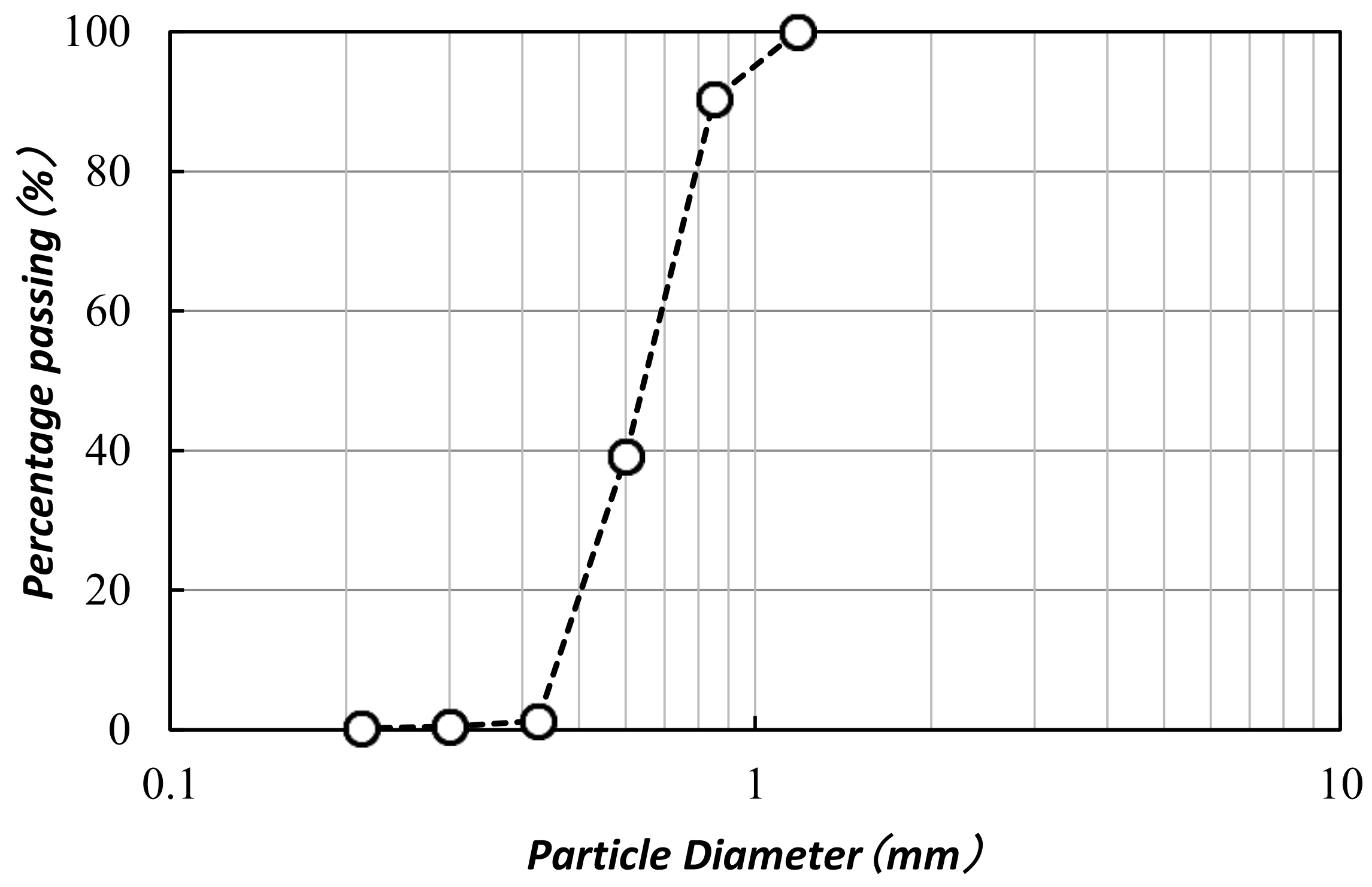

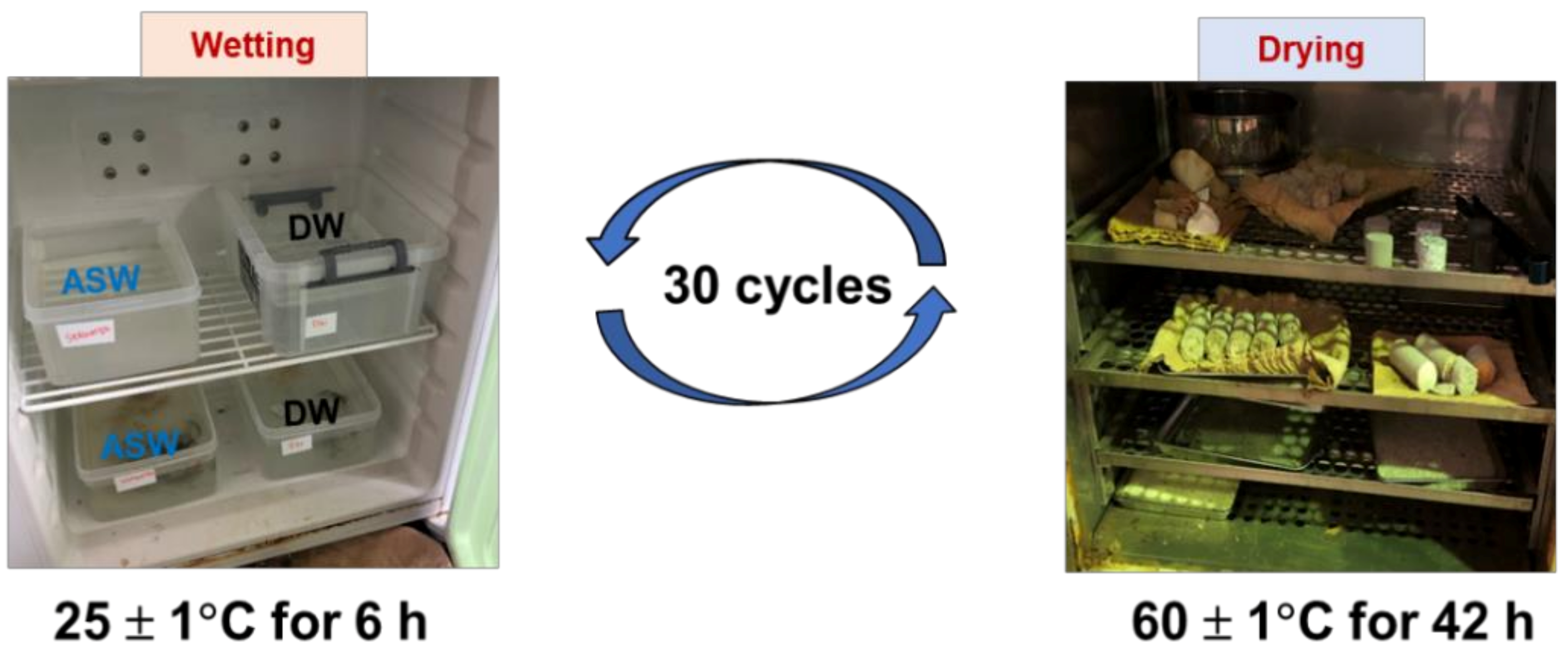


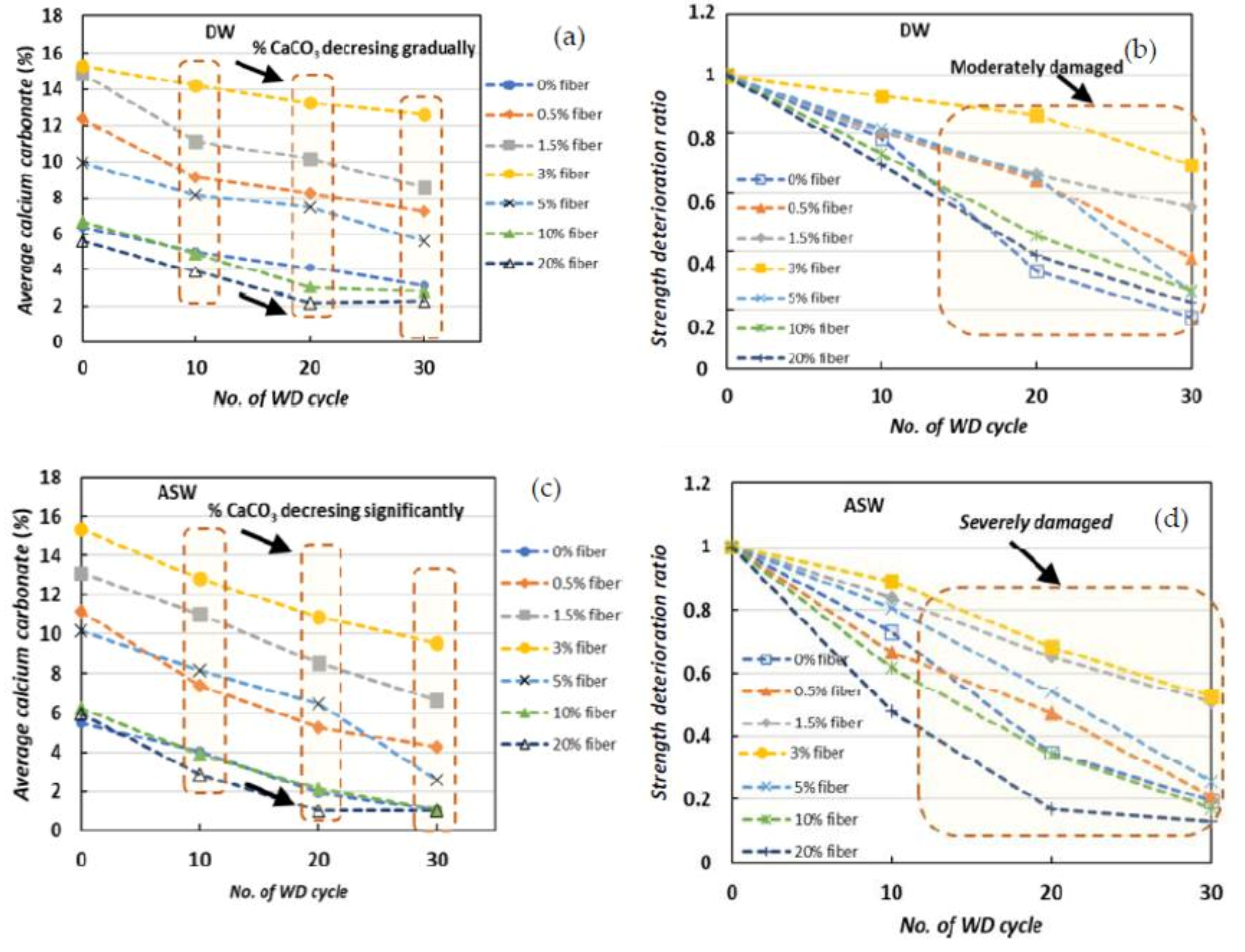
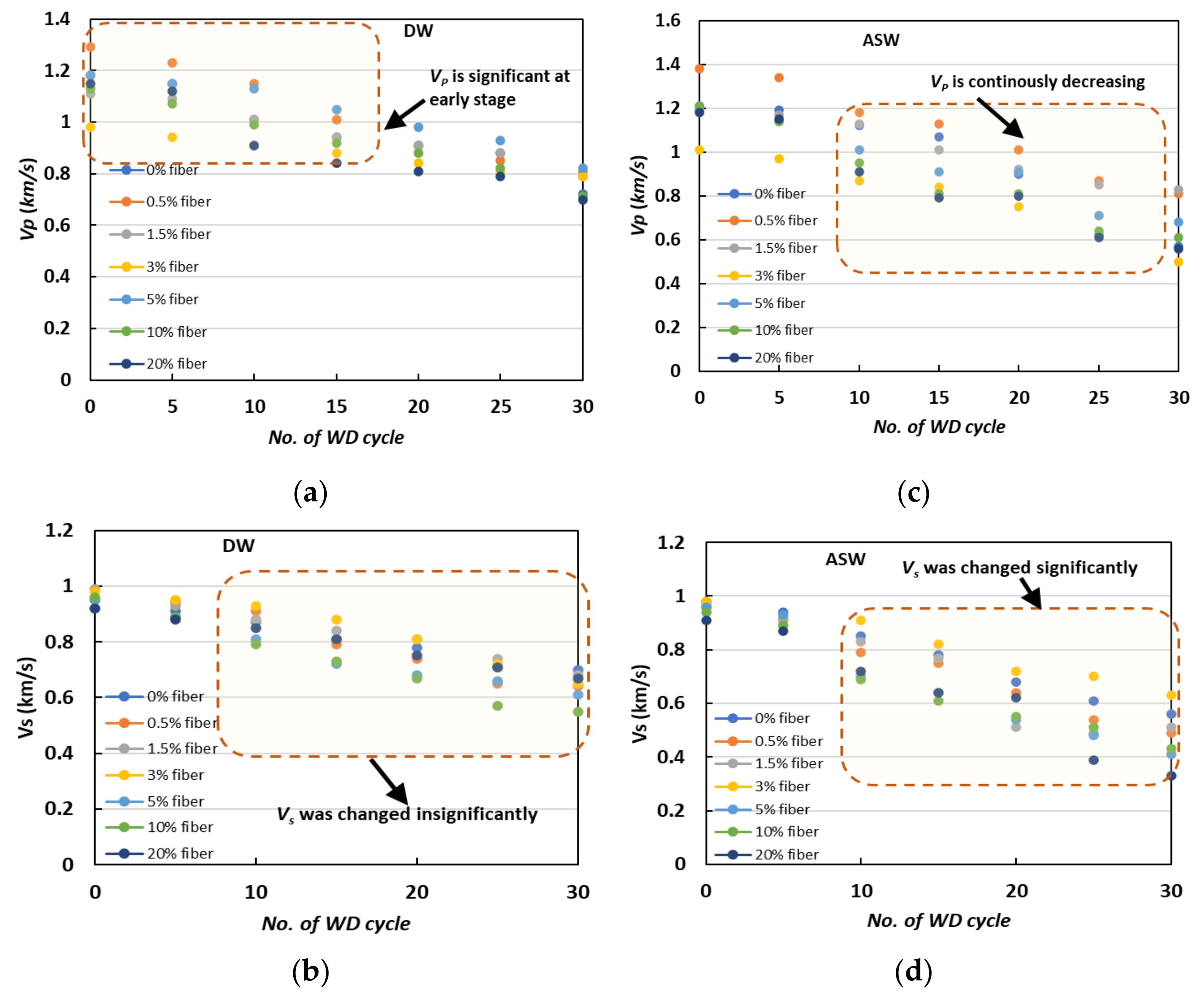
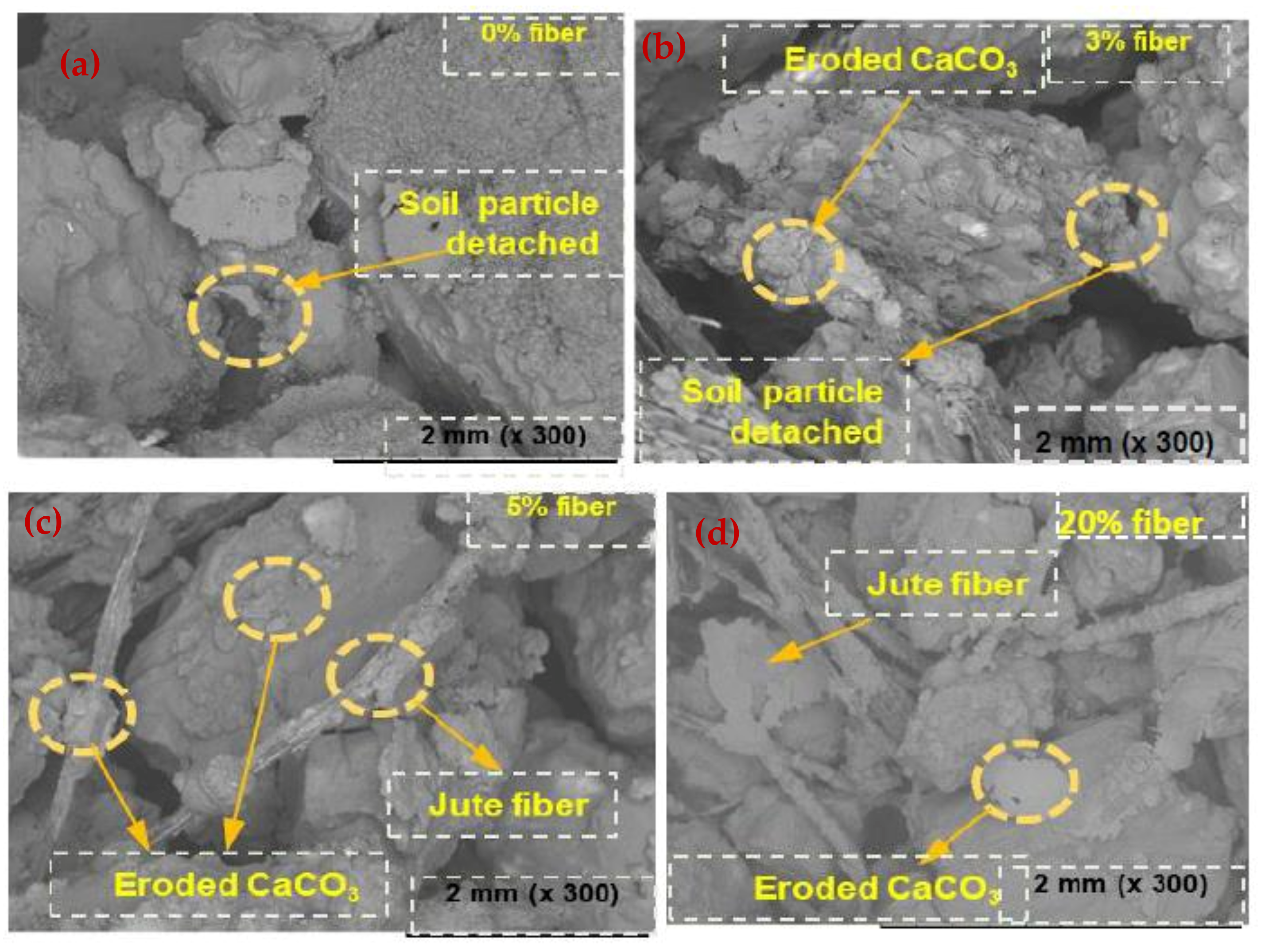
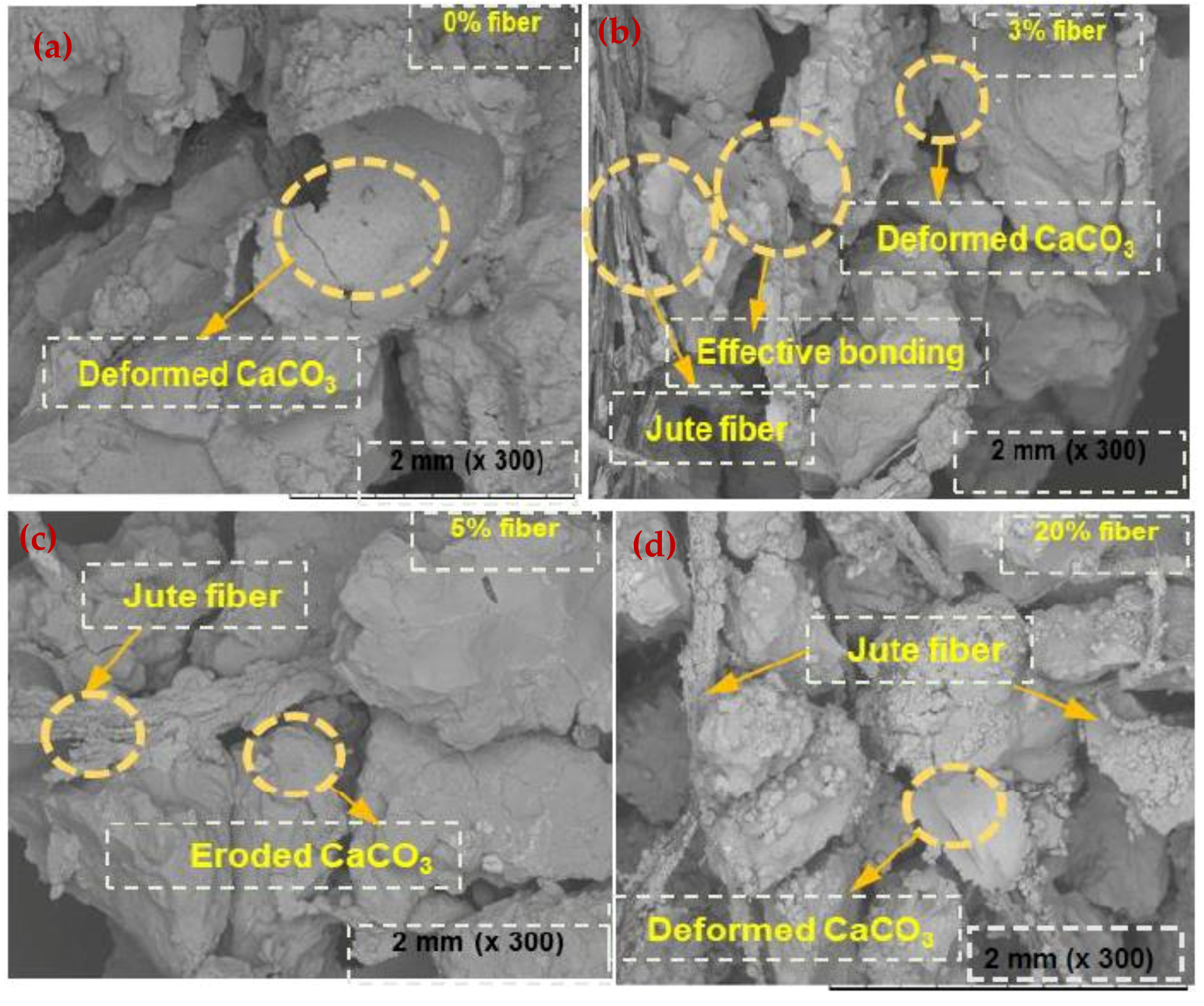
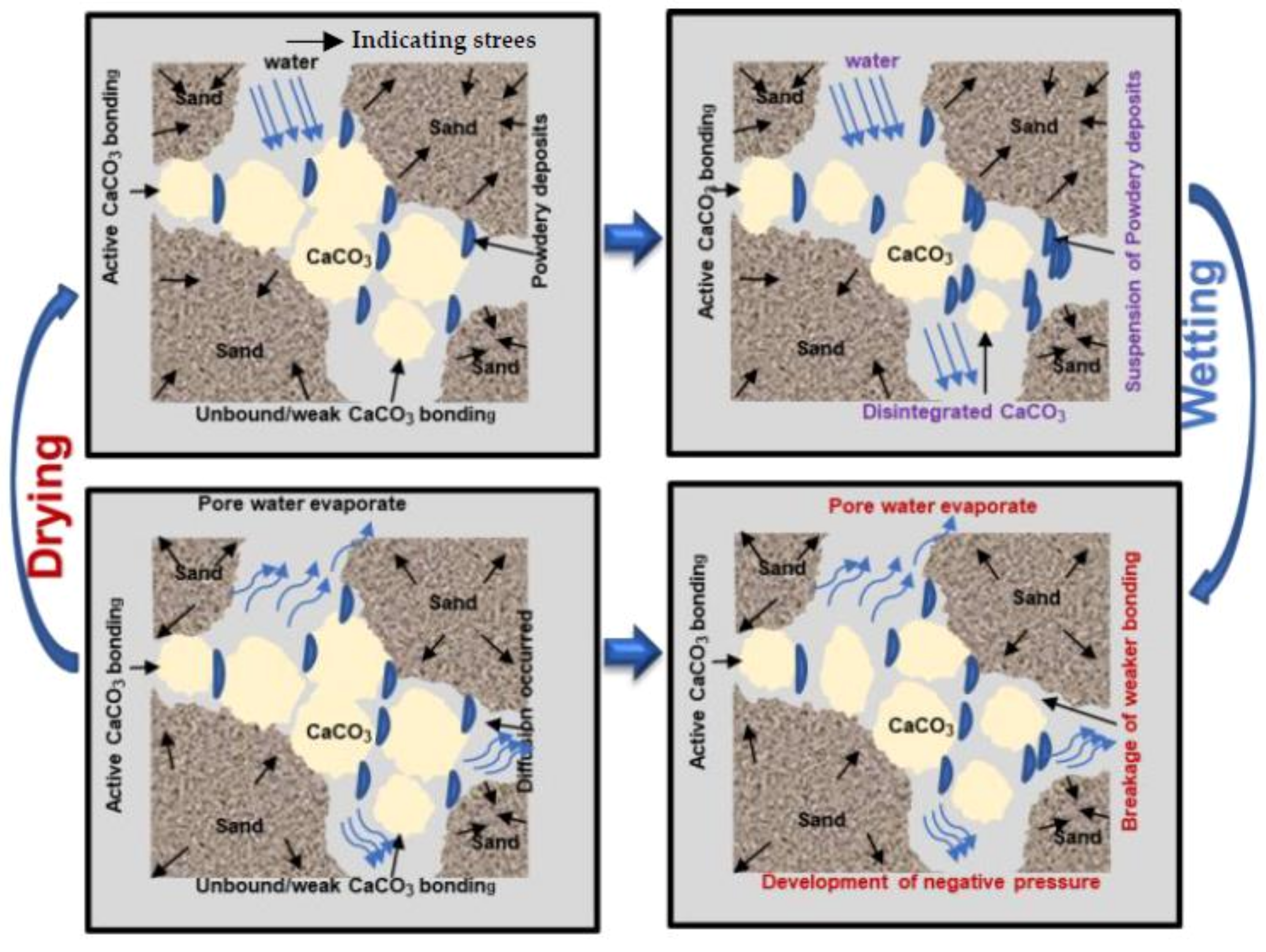

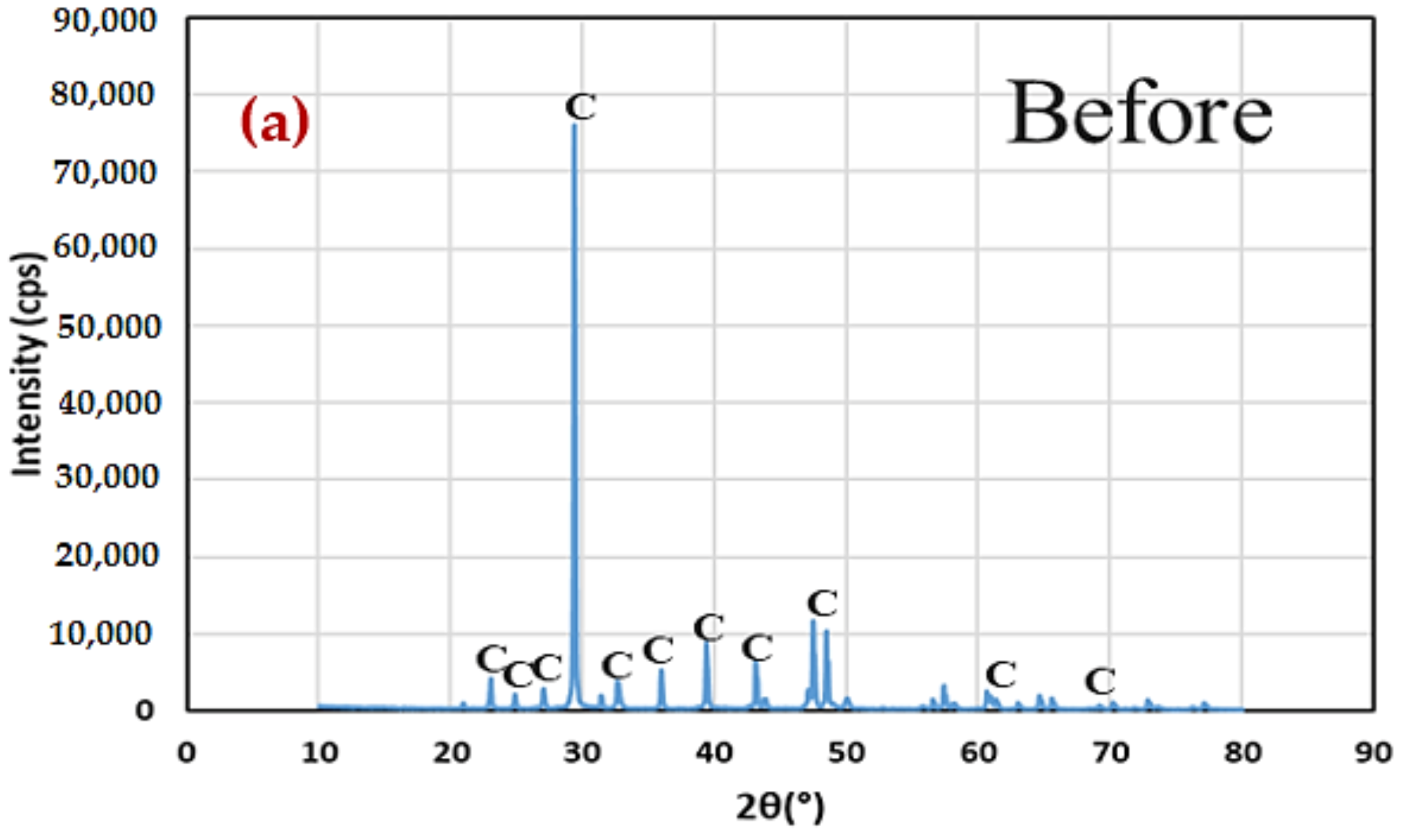
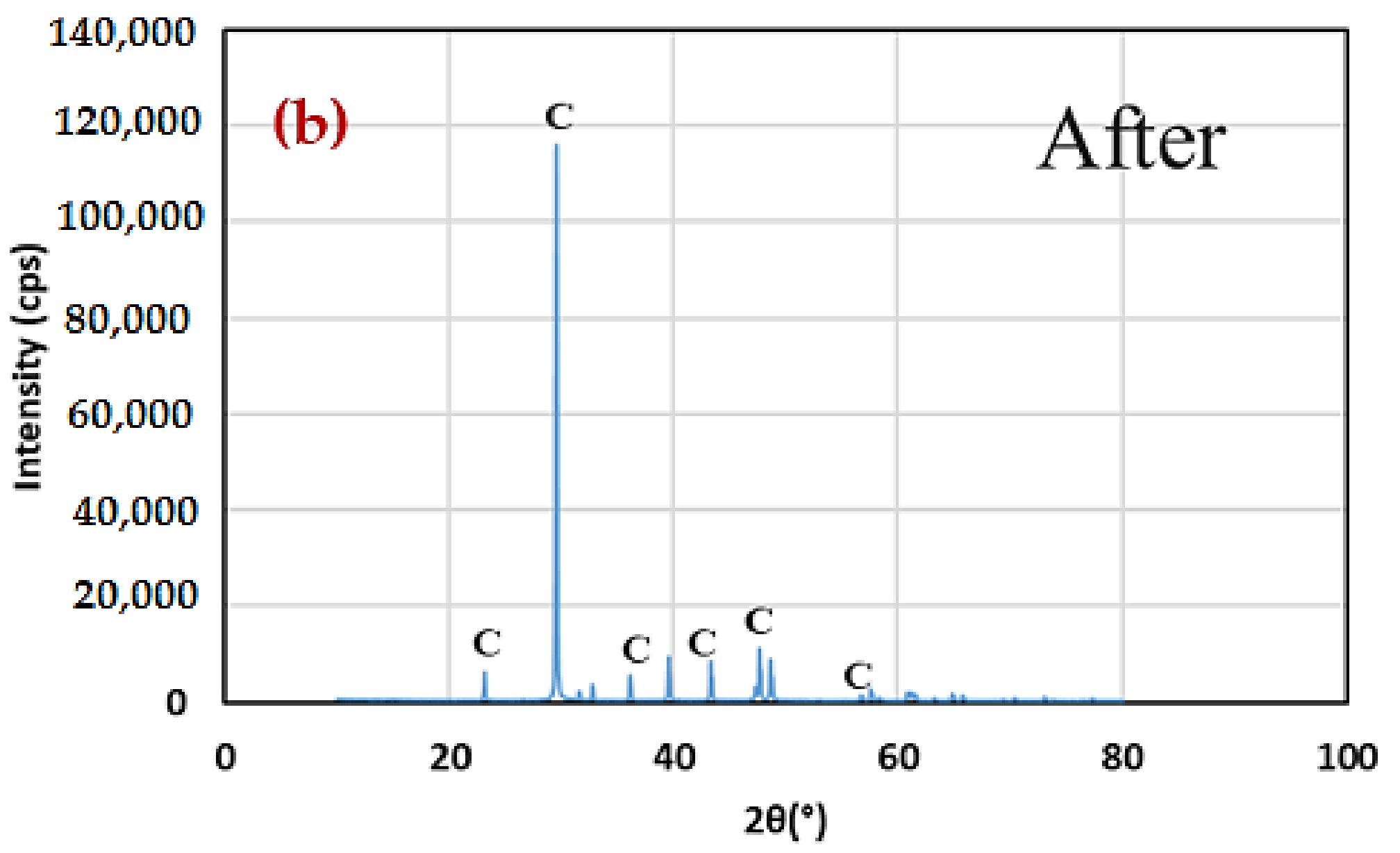
| Fiber Name | Density | Range | Weight | Pattern | Moisture Content | Complexion |
|---|---|---|---|---|---|---|
| Jute | 2 mm | 510 m | 900 g | Roll | 3.4% | Golden-brown |
| Testing Cases | Fiber Content ((%) mm) | Number of MICP Treatments | Immersion Time (h) | Curing Temperature (°C) | Total WD Cycles | Treatment Method |
|---|---|---|---|---|---|---|
| 0 | 0 | 14 | 6 | 25 ± 1 | 30 | Distilled water (DW) (fully submerged) |
| 1 | ((0.5) 15) | 14 | 6 | 25 ± 1 | 30 | |
| 2 | ((1.5) 15) | 14 | 6 | 25 ± 1 | 30 | |
| 3 | ((3) 15) | 14 | 6 | 25 ± 1 | 30 | |
| 4 | ((5) 15) | 14 | 6 | 25 ± 1 | 30 | |
| 5 | ((10) 15) | 14 | 6 | 25 ± 1 | 30 | |
| 6 | ((20) 15) | 14 | 6 | 25 ± 1 | 30 |
| Testing Cases | Fiber Content ((%) mm) | Number of MICP Treatments | Immersion Time (h) | Curing Temperature (°C) | Total WD Cycles | Treatment Method |
|---|---|---|---|---|---|---|
| 0 | 0 | 14 | 6 | 25 ± 1 | 30 | Artificial seawater (ASW) (fully submerged) |
| 1 | ((0.5) 15) | 14 | 6 | 25 ± 1 | 30 | |
| 2 | ((1.5) 15) | 14 | 6 | 25 ± 1 | 30 | |
| 3 | ((3) 15) | 14 | 6 | 25 ± 1 | 30 | |
| 4 | ((5) 15) | 14 | 6 | 25 ± 1 | 30 | |
| 5 | ((10) 15) | 14 | 6 | 25 ± 1 | 30 | |
| 6 | ((20) 15) | 14 | 6 | 25 ± 1 | 30 |
Publisher’s Note: MDPI stays neutral with regard to jurisdictional claims in published maps and institutional affiliations. |
© 2022 by the authors. Licensee MDPI, Basel, Switzerland. This article is an open access article distributed under the terms and conditions of the Creative Commons Attribution (CC BY) license (https://creativecommons.org/licenses/by/4.0/).
Share and Cite
Imran, M.A.; Nakashima, K.; Evelpidou, N.; Kawasaki, S. Durability Improvement of Biocemented Sand by Fiber-Reinforced MICP for Coastal Erosion Protection. Materials 2022, 15, 2389. https://doi.org/10.3390/ma15072389
Imran MA, Nakashima K, Evelpidou N, Kawasaki S. Durability Improvement of Biocemented Sand by Fiber-Reinforced MICP for Coastal Erosion Protection. Materials. 2022; 15(7):2389. https://doi.org/10.3390/ma15072389
Chicago/Turabian StyleImran, Md Al, Kazunori Nakashima, Niki Evelpidou, and Satoru Kawasaki. 2022. "Durability Improvement of Biocemented Sand by Fiber-Reinforced MICP for Coastal Erosion Protection" Materials 15, no. 7: 2389. https://doi.org/10.3390/ma15072389
APA StyleImran, M. A., Nakashima, K., Evelpidou, N., & Kawasaki, S. (2022). Durability Improvement of Biocemented Sand by Fiber-Reinforced MICP for Coastal Erosion Protection. Materials, 15(7), 2389. https://doi.org/10.3390/ma15072389









